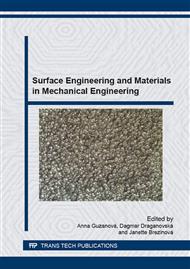p.252
p.256
p.260
p.264
p.268
p.272
p.276
p.280
p.284
The Evaluation of Surface Quality for Particular Parts of Forging Die
Abstract:
Forming dies are often costly for producers and the cost amount is influenced by production process too. If the die is manufactured by machining, proper strategies would necessary to consider as well. The right selection of adequate strategy helps production times shortening, tool wear reducing and those affect production effectiveness. Used strategies and its parameters are often compromise between acceptable surface quality and variations in shape aside, and production time on the other side. The paper presents the way of evaluation of milling strategy based on selected elements of forming die. This allows choosing the adequate strategy for particular shapes of die and also to evaluate them by the reached surface quality. Presented approach is verified by machining forging die cavity for production of connecting rod.
Info:
Periodical:
Pages:
268-271
Citation:
Online since:
May 2015
Authors:
Keywords:
Price:
Сopyright:
© 2015 Trans Tech Publications Ltd. All Rights Reserved
Share:
Citation:


